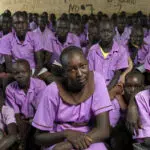Media Centre - 12 August 2022
Still Invisible: New report finds half a billion teenage girls remain unseen and underfunded in Australian aid
A staggering 500 million adolescent girls around the world are at risk of gender-based violence, exclusion from education or are missing out on reaching their economic and leadership potential, with half of these girls in the Asia-Pacific region, according to a new report by Plan International, Australia the charity for girls’ equality.
Girls to the front: Time for foreign aid to see adolescent girls – released today on International Youth Day – highlights that adolescent girls are being overlooked in the Australian aid program and urges the Labor Government to urgently scale up funding to programs that support girls, or else risk an entire generation being lost to the ongoing shockwaves of the COVID-19 crisis.
“We know that girls are always the hardest hit in a crisis, and COVID-19 is no exception,” said Susanne Legena, CEO of Plan International Australia. “In the past two years, rates of child marriage have risen for the first time in a generation, and many girls may never return to school following widespread lockdowns. Yet despite facing long-term setbacks to their education, safety and freedom, these girls are all but invisible in Australia’s aid program.”
Plan International Australia is calling on the Labor Government to increase overseas aid investment in the 2022 budget towards adolescent girls and gender diverse young people to ensure that they can live free from violence, get back into school, and become agents of change.
The participation, education and safety of adolescent girls is vital to economic development, gender equality and climate action regionally and across the world.
However a new report and policy review by the charity found that while adolescent girls in developing countries are still bearing the brunt of the COVID-19 crisis and its devastating secondary impacts – they are mostly overlooked in Australia’s overseas aid.
The report also included a survey of more than 1,000 women and gender diverse people aged 18-24 on perceptions and opinions on Australian foreign aid – and it shows that young Australians overwhelming agree that Australia needs to do more to ensure all girls can thrive.
The polling found 85% think that the Australian Government should increase efforts to support local actions that protect and uphold girls’ rights and freedoms across the world, while 84% believe that having the Australian aid program help girls access secondary school will vastly improve gender equality across the world.
Plan International Australia estimates there are 500 million teenage girls currently living in the developing world, yet their priorities are not adequately reflected in the Australian Government’s current foreign aid policies. Despite the challenges facing adolescent girls, especially in our region, there has been little change in investment since 2016.
Although critical to climate action and gender equality, the distinct needs of adolescent girls often fall through the cracks of traditional efforts designed for women, younger girls and children. This is a critical time, when they are at most risk of being pulled out of school, child and early forced marriage, early pregnancy and labor exploitation.
Through a review of the Federal Government’s COVID-19 Development response plan, Development Program Progress Reports, aid policies and strategies, multilateral institutions and funding flows and teenage girls themselves, the report found little reference to adolescent girls across six priorities areas for investment: secondary education; sexual and reproductive health information and services; young women and girls’ leadership; economic empowerment of girls and young women; gender-based violence initiatives focused on adolescent girls; and adolescent girls in emergencies.
“With a new Government this year setting the blueprint for our next Federal Budget, now is Australia’s chance to unlock the potential of adolescent girls around the world,” added Legena.
“We know that girls are incredible agents of change and have the power to create a better future for themselves and others like them, and when we invest in girls – when we give them the tools to learn, lead, decide and thrive – they can change the world. They are already leading climate justice movements, they are fighting for their right to be heard in political forums; and demanding their right to be safe in their homes, online and in public places. Yet their rights, freedoms and education have seen devastating setbacks in recent years, particularly as a result of COVID-19 and the escalating humanitarian crises around the world.
“The harsh reality is that adolescent girls are still not being prioritised in investments or policies, either in Australia or internationally. The world talks about focusing on ‘women and girls’ in aid and development, but in practice investments still target adult women or younger children, and adolescent girls aged 10 to 19 fall through the gap.
“We are calling on all Australians – parliamentarians, policymakers, donors and individuals – to recognise that investing in adolescent girls can and will be life-changing for those half a billion girls, and their families, who they can help lift out of poverty.
“Whether we are trying to empower girls to further their education, avoid child marriage, access family planning services or escape gender-based violence, we cannot improve girls’ realities without first acknowledging that their challenges and needs are unique.
“As the global food crisis grows increasingly critical, we also know that millions of girls are at risk of malnutrition and starvation, with girls often being the last to eat when food is scarce. Australia has an opportunity to change this, by ensuring more of our aid investments directly prioritise girls,” she added.
Key facts and statistics on teenage girls in the developing world:
- There are over 500 million adolescent girls aged 10-19 living in developing countries.
- Importantly, more than half the global population of adolescent girls are in the Asia Pacific region. Our neighbours in South Asia host a staggering 340 million adolescents, and East Asia and the Pacific are home to 277 million.
- In the Sub-Saharan region, 10 to 19 year olds make up almost one quarter of the region’s population. In Afghanistan, almost half of the population is under 18.
- The United Nations Population Fund has recognised girls aged 10 as the key group whose potential, if unlocked, will create the economic and social conditions needed to achieve the 2030 Agenda for Sustainable Development.
- If all the 10-year-old girls who drop out of school or do not attend school in developing countries completed secondary education, they would contribute $21 billion a year to their economies.
- 650 million girls and women alive today were married as children. In South Sudan, 52 per cent of all girls are married before 18 years of age.
- As a result of COVID-19, it is estimated that 10 million additional child marriages may occur before 2030. This increase is set to reverse 25 years of progress, which saw child marriage rates decline.
- The pandemic has also caused significant delays in programs to end female genital mutilation (FGM), resulting in an estimated 2 million more cases of FGM over the next decade than would have otherwise occurred.
- Pregnancy related complications are the leading cause of death for adolescent girls aged 15 to 19. Every day 507 women and adolescent girls die from pregnancy related causes in countries that are fragile states affected by conflict or disaster.
“The elevation of women to leadership roles cannot occur without those women being safe, educated and empowered in adolescence. In working with and centering adolescent girls in all their diversity, we can together challenge unequal gendered power relations and norms which determine whether or not adolescent girls in our region can realise their rights,” Legena added.
Media contacts


